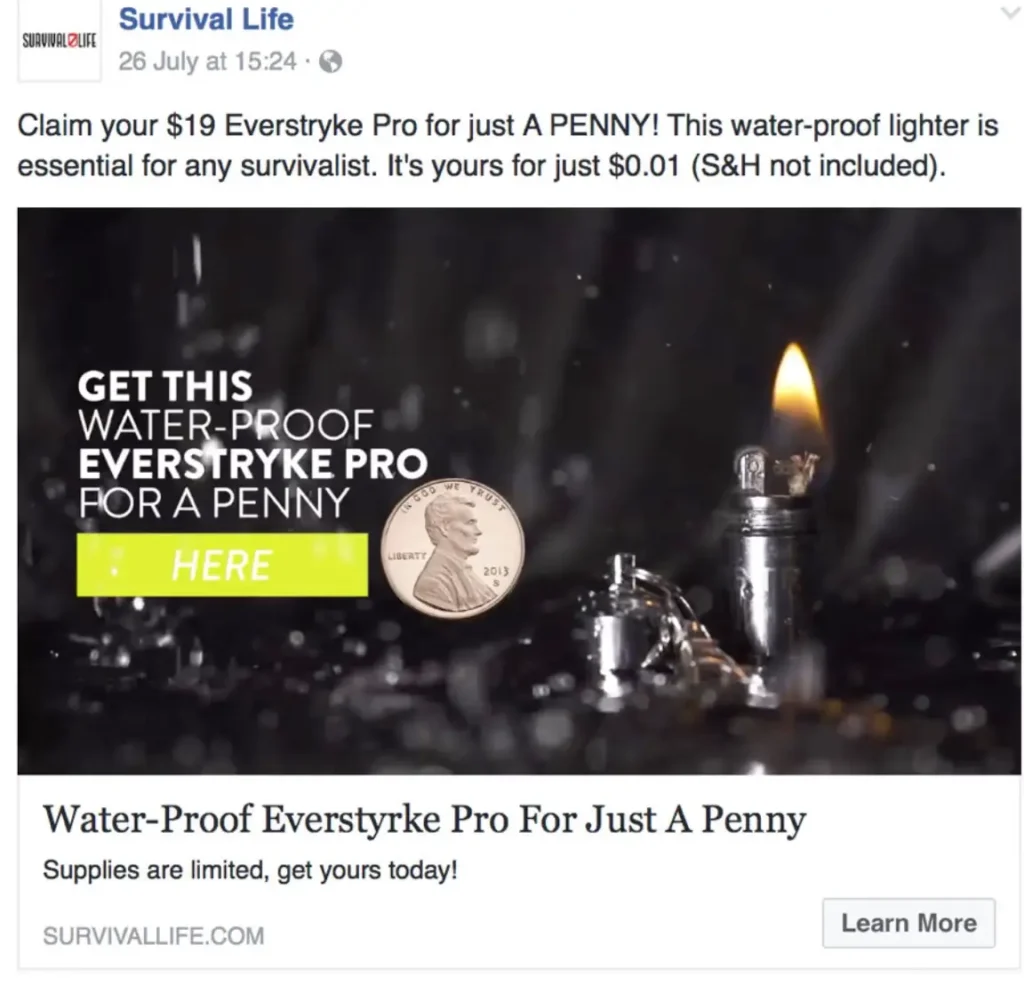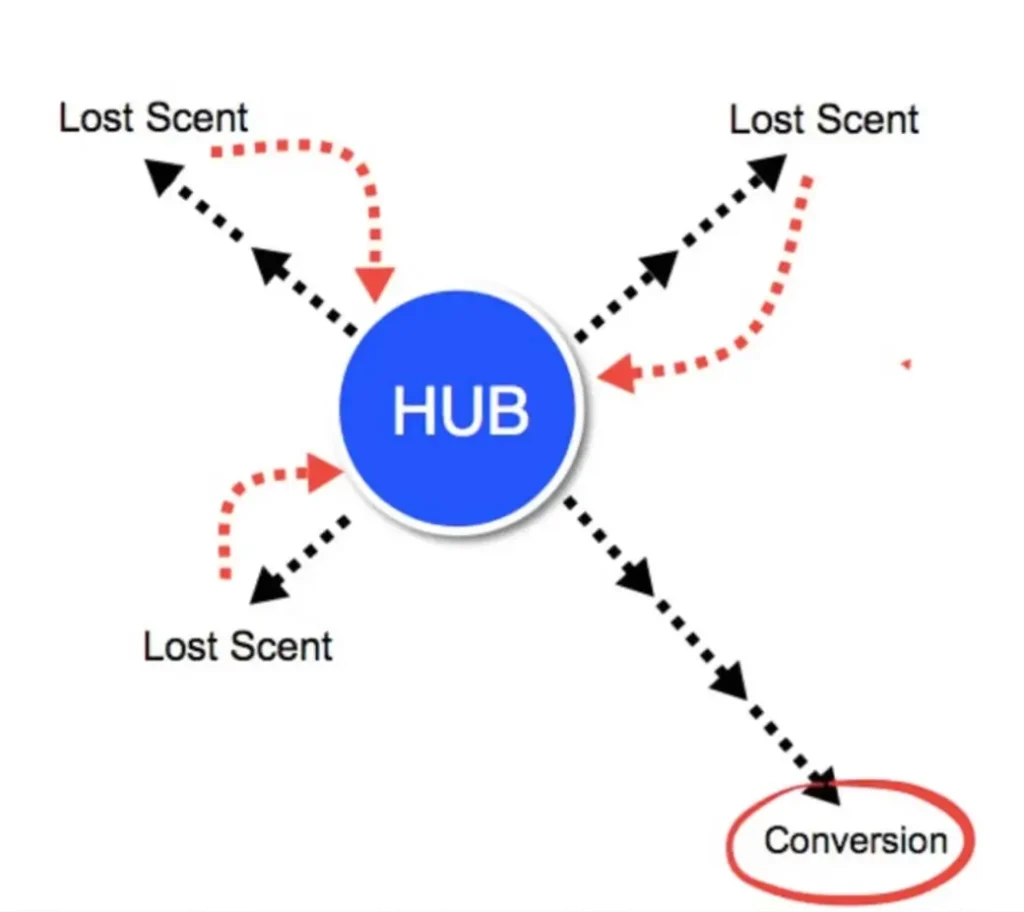Every ad campaign is made up of 5 key elements: the offer itself, the ad’s copy, the ad’s design (which we call the “creative”), the ad scent (the cohesive look and feel of your overall campaign), and the targeting, or who you pitch your offer to.
1. Your Offer
Your offer is not the same thing as your product or service. Your business is built around a product; your ad campaign is built around an offer. So what is an offer? It’s the unique combination of your product or service with other bonuses or add-ons, including all the details of your promotion:
The deliverables:
- The price
- The schedule
- How it’s being delivered
- And more
So, you may only have one product, but you can offer it for sale in a variety of ways, creating hundreds of different offers.
Example: Survival Life, offers a valuable product for just a penny:

Your offer is the key conversion point for your ad campaign. Get it right, and everything else will usually fall into place. But the opposite is just as true: put together a bad offer, and your ad won’t convert.
2. Your Copy
Your ad copy refers to the messaging you use in your ad campaign. It should be clear and compelling, so the benefits stand out—both the benefits of engaging with the ad and of taking whatever action you’re asking for. Good copy has a strong emotional hook. It’s intriguing and persuasive without relying on hype.
Generally, you want to start your ad by speaking to a pain point your target is dealing with. Then your offer should be presented as the solution. This Hired promotion leads with the problem: “counting down the hours until you get to leave the office.” If someone resonates with that problem, they’ll be eager to see the solution.

Or take this example from WINC:

3. The Creative
Creative refers to the graphic elements of your ad: the image, video, or carousel images. Don’t be fooled by the term “creative.” It doesn’t have to be overly imaginative. Good creative communicates your message visually in just a second or two. So, it supports and enhances your copy. Whenever possible, we visually display the offer, so people know at a glance what the deliverable is.
Your creative should communicate your message visually in 1-2 seconds.
4. Ad Scent
Ad scent refers to congruency, or “sameness,” throughout your campaign. Why is this important? Because trust is a huge conversion factor. If people feel comfortable that your offer is valid, they’ll seriously consider your offer. Do anything to create doubt or fear, and they’ll exit without taking action. Here’s how ad scent works…

Every time we click, we use simple visual cues (or scent) to ensure we’re in the right place. If we lose scent at any point, we begin to feel we’re in the wrong place or that we’re being tricked. As soon as that happens, we exit and go back to where we started. Your visitors should always feel like they’re on the right path. You do this by creating a flow—visually, in your messaging, and in the presentation of your offer—from your ad to your landing page, and every other piece of your campaign.
To create congruency, focus on 3 elements:
- Design: Use similar imagery and colours on each piece of the campaign.
- Messaging: Use similar phrases and benefits.
- Offer: Your offer should be the same throughout.
Ad scent is low-hanging fruit in digital advertising. Get it right, and you’ll boost your conversion rate and lower costs.
See how Whole Foods does it in this ad:

The ad mentions “FREE Instacart delivery,” and when they click, they land on a page with similar wording in the headline: “Free Delivery Credit.” If the landing page talked about keeping your fruit fresh or any other topic unrelated to free delivery, it would confuse people, and they’d click off without taking action. That’s why it’s important to create a strong scent between the elements of your campaign.
5. Targeting
The final element in a high-performing ad campaign is targeting, and it’s important because even a great offer won’t convert if you put it in front of the wrong audience. Follow 2 rules of thumb when planning your targeting.
First, be as specific as possible.
Specificity has to do with research. When planning your targeting, learn as much as possible about your target audience. You want to know your target audience so well, you can single out specific interests that this group has but no one else would have.
Second, get the message right for your target temperature.
Temperature, as we talked about earlier, has to do with matching your message to the level of relationship you have with your target audience. Here are some guidelines for getting the temperature right.
Cold Traffic: Here, you’re just introducing yourself to new audiences, so you have 3 goals (none of them being to sell):
- Indoctrination: Aim to build trust and establish credibility by sharing valuable information for free.
- Pixelling: When they arrive on your content, pixel them so you run more ads to them and warm them up.
- Segmentation: If they click on a blog post about email marketing, we know they’re interested in that topic, so we can make them a more relevant offer later.
What kind of offers do you make to cold traffic?
- Blog posts
- Social media updates
- Content videos
- Podcasts
- Lead magnets
- Quizzes
- White papers
- YouTube ads to content
- Twitter ads to pillar content
- Infographics
When paying for cold traffic, you’ll pixel people who engage with your ad or click through to free content. You want to give them value so they begin to like your brand. So focus on entertaining, inspiring, and educating everyone who clicks through.
Warm Traffic
Warm Traffic: Think about warm traffic as acquaintances who have shown interest in return. It’s not a developed relationship yet, but there has been a connection. So you’ll target these ads to:
- Leads that opted into your email list. (You’ll upload that list to a traffic platform.)
- People who have visited your website and been pixeled.
- Facebook fans, Twitter followers, YouTube channel subscribers, etc.
- Your goals for warm traffic are to:
- Generate leads
- Drive low-dollar sales
- What kind of offers do you make to warm traffic?
- Lead magnets
- Quizzes or surveys
- Free or paid webinars
- Flash sales/low-dollar offers
- Product demos
- Branding videos
- Books (free or paid)
- Free trials
Hot Traffic
Hot Traffic: These are your buyers. They may be people who have opted in and are on the fence about buying from you. They may have added products to the shopping cart but never purchased. They may have purchased something from you in the past but haven’t responded to recent offers.
Your goals in running ads to this group are:
- Activation. If they haven’t purchased in a while, remind them that you’re still there.
- High-dollar sales. Upsell buyers of lower-priced products.
- What kind of offers do you make to hot traffic?
- Events
- Paid webinars
- High-dollar offers
- Done-for-you services
Cold, warm, or hot, getting the temperature right allows you to put your campaign in front of the right people. And the more precisely you can target your ads, the better they’ll perform.
References:
Digital Marketer. (n.d.). The Ultimate Guide to Digital Marketing. Course Hero. Retrieved January 25, 2022, from https://www.coursehero.com/file/94978188/Ultimate-Guide-to-Digital-Marketingpdf/

